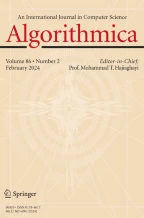Abstract
We revisit the problem of finding a 1-restricted simple 2-matching of maximum cardinality. Recall that, given an undirected graph \({\varvec{G = (V, E)}}\), a simple 2-matching is a subset \({\varvec{M}} \subseteq {\varvec{E}}\) of edges such that each node in \({\varvec{V}}\) is incident to at most two edges in \({\varvec{M}}\). Clearly, each such \({\varvec{M}}\) decomposes into a node-disjoint collection of paths and circuits. \({\varvec{M}}\) is called 1-restricted if it contains no isolated edges (i.e. paths of length one). A combinatorial polynomial algorithm for finding such \({\varvec{M}}\) of maximum cardinality and also a min-max relation were devised by Hartvigsen. It was shown that finding such \({\varvec{M}}\) amounts to computing a (not necessarily 1-restricted) simple 2-matching \({\varvec{M}}_{\varvec{0}}\) of maximum cardinality and subsequently altering it into \({\varvec{M}}\) of the same cardinality so as to minimize the number of isolated edges. While the first phase (which computes \({\varvec{M}}_{\varvec{0}}\)) runs in \({\varvec{O}}\left( {\varvec{E}} \sqrt{V}\right) \) time, the second one (which turns \({\varvec{M}}_{\varvec{0}}\) into \({\varvec{M}}\)) requires \({\varvec{O(VE)}}\) time. In this paper we apply the general blocking augmentation approach (initially introduced, e.g., for bipartite matchings by Hopcroft and Karp, and also by Dinic) and present a novel algorithm that reduces the time needed for the second phase to \({\varvec{O}}\left( \textbf{E} \sqrt{V}\right) \) thus completely closing the gap between 1-restricted and unrestricted cases.
Similar content being viewed by others
References
Hartvigsen, D.: Maximum cardinality 1-restricted simple 2-matchings. Electron. J. Comb. 14(1), R73 (2007)
Goldberg, A.V., Karzanov, A.V.: Maximum skew-symmetric flows and matchings. Math. Progr. 100(3), 537–568 (2004)
Hopcroft, J.E., Karp, R.M.: An \(n^{5/2}\) algorithm for maximum matchings in bipartite graphs. SIAM J. Comput. 2(4), 225–231 (1973)
Kaneko, A.: A necessary and sufficient condition for the existence of a path factor every component of which is a path of length at least two. J. Comb. Theory Ser. B 88(2), 195–218 (2003). https://doi.org/10.1016/S0095-8956(03)00027-3
Kano, M., Katona, G.Y., Király, Z.: Packing paths of length at least two. Discret. Math. 283(1–3), 129–135 (2004). https://doi.org/10.1016/j.disc.2004.01.016
Hartvigsen, D., Hell, P., Szabó, J.: The k-piece packing problem. J. Graph Theory 52(4), 267–293 (2006). https://doi.org/10.1002/jgt.20161
Artamonov, S., Babenko, M.A.: Faster algorithm for finding maximum 1-restricted simple 2-matchings. In: Bazgan, C., Fernau, H. (eds.) Combinatorial Algorithms - 33rd International Workshop, IWOCA 2022, Trier, Germany, June 7–9, 2022, Proceedings. Lecture Notes in Computer Science, vol. 13270, pp. 86–100. Springer, NY (2022)
Lovász, L., Plummer, M.D.: Matching Theory. North-Holland, NY (1986)
Funding
The authors did not receive support from any organization for the submitted work.
Author information
Authors and Affiliations
Corresponding author
Ethics declarations
Conflict of interest
The authors have no relevant financial or non-financial interests to disclose.
Additional information
Publisher's Note
Springer Nature remains neutral with regard to jurisdictional claims in published maps and institutional affiliations.
Rights and permissions
Springer Nature or its licensor (e.g. a society or other partner) holds exclusive rights to this article under a publishing agreement with the author(s) or other rightsholder(s); author self-archiving of the accepted manuscript version of this article is solely governed by the terms of such publishing agreement and applicable law.
About this article
Cite this article
Artamonov, S., Babenko, M. Faster Algorithm for Finding Maximum 1-Restricted Simple 2-Matchings. Algorithmica 86, 717–734 (2024). https://doi.org/10.1007/s00453-023-01148-6
Received:
Accepted:
Published:
Issue Date:
DOI: https://doi.org/10.1007/s00453-023-01148-6
